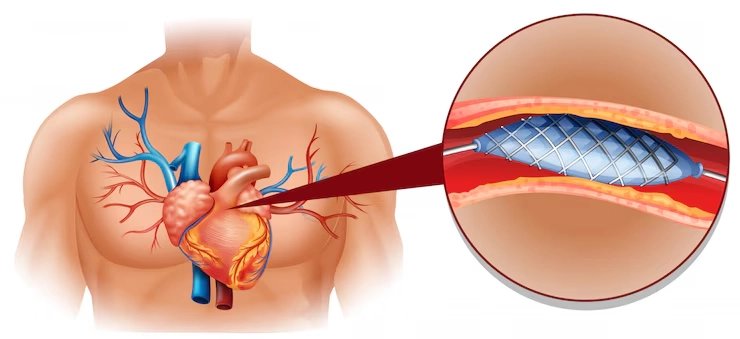Left main stenting is a minimally invasive procedure used to treat blockages or narrowing in the left main coronary artery. This critical artery is responsible for providing blood flow to the left side of the heart. When this artery becomes narrowed or blocked due to atherosclerosis (build-up of plaque), it can lead to reduced blood flow and potentially life-threatening complications, such as a heart attack or heart failure. Left main stenting in Chennai is a procedure that involves inserting a stent (a small mesh tube) into the narrowed section of the artery to restore blood flow.
What is Left Main Stenting?
Left Main Stenting is a procedure used to treat blockages in the left main coronary artery, which supplies blood to a large portion of the heart. A metallic stent is placed to keep the artery open, restoring proper blood flow. This minimally invasive approach is an alternative to bypass surgery for selected patients with coronary artery disease.
Symptoms of Left Main Stenting
The symptoms of left main stenosis or blockage can vary from person to person. Common symptoms may include chest pain (angina) or discomfort, shortness of breath, fatigue, dizziness, or even fainting. In some cases, there may be rare or no symptoms at all. If left untreated, left main stenosis can lead to severe complications, including heart attack or sudden cardiac arrest.

Causes of Left Main Stenting
The primary cause of left main stenting in Chennai is the development of atherosclerosis, which involves the build-up of plaque inside the arteries. Plaque consists of fat, calcium, cholesterol, and other substances. The primary causes include:
- Atherosclerosis – Buildup of plaque in the arteries, narrowing blood flow.
- Coronary Artery Disease (CAD) – Progressive narrowing of the heart’s arteries, often leading to left main artery blockage.
- High Cholesterol – Excess cholesterol leads to plaque formation, restricting blood supply.
- Hypertension (High Blood Pressure) – Increased pressure damages artery walls, contributing to blockages.
- Smoking – Damages blood vessels and accelerates plaque buildup.
- Diabetes – Increases the risk of coronary artery disease and arterial blockages.
- Genetic Factors – A family history of heart disease raises the likelihood of left main artery obstruction.
Early diagnosis and timely intervention can prevent complications and improve heart health.
Diagnosis and Tests
To diagnose left main stenosis, a comprehensive evaluation is necessary. A medical history review, physical examination, and assessment of symptoms are often the first steps. Various diagnostic tests may be performed, including an electrocardiogram (ECG), stress tests, echocardiography, cardiac catheterization, or coronary angiography.
These tests provide information about the severity and location of the blockage and help guide treatment decisions.
Benefits and Risks of Left Main Stenting in Chennai
Left main coronary artery stenting is a procedure that can alleviate symptoms of heart disease and improve blood flow to the heart. Benefits include reduced angina and improved quality of life. Risks involve stent-related complications, clot formation, or heart attack. Consultation with a cardiologist is crucial for informed decision-making.
Benefits
Left main stenting in Chennai offers several significant benefits for individuals with left main stenosis. Firstly, it restores proper blood flow to the heart muscle, improving oxygen and nutrient supply and alleviating symptoms such as chest pain and fatigue. By reducing the blockage, it also lowers the risk of life-threatening complications like heart attack and heart failure.
Additionally, it is a minimally invasive procedure, resulting in shorter hospital stays, reduced pain, minimal scarring, and quicker recovery compared to open-heart surgery. Overall, left main stenting improves cardiac health, relieves symptoms, and enhances the quality of life for individuals with left main stenosis.
Risks
Left main stenting, while offering numerous benefits, carries certain risks and potential complications. These include the possibility of restenosis, where the treated artery may narrow again due to scar tissue formation or recurring plaque buildup. Stent thrombosis, the formation of blood clots within the stent, poses a risk that can be mitigated by appropriate medication. Infection or excessive bleeding at the catheter insertion site, although rare, are potential complications.
Allergic reactions to contrast dye used during the left main stenting in Chennai are possible but uncommon. Finally, there is a slight risk of coronary artery dissection, which may require further intervention. Close monitoring and communication with healthcare professionals can help manage these risks effectively.
Management and Treatment
The management and treatment of left main stenosis depend on several factors, including the severity of the blockage, the patient’s overall health, and the presence of other heart conditions. In some cases, lifestyle modifications may be recommended, such as adopting a heart-healthy diet, regular exercise, smoking cessation, and weight management.
Medication may also be prescribed to control symptoms and reduce the risk of complications. Medications commonly used include aspirin, beta-blockers, cholesterol-lowering drugs (statins), and antiplatelet agents.
It is a common treatment approach for significant blockages in the left main artery. During the procedure of left main stenting in Chennai, a catheter with a deflated balloon and a stent is inserted into the narrowed artery. The balloon is inflated to expand the stent, which helps hold the artery open, allowing improved blood flow to the heart. After the stent is in place, the balloon is deflated and removed, leaving the stent permanently in place.
In some cases, left main stenting may be followed by medication or additional interventions, such as coronary artery bypass grafting (CABG). CABG involves creating new pathways for blood flow by using blood vessels from other parts of the body to bypass the blocked section of the coronary artery.
Cost of a Stent in Chennai
The cost of a stent in Chennai varies depending on factors such as the type of stent, hospital, and surgeon’s expertise. The price range typically falls between ₹25,000 and ₹2,50,000 per stent.
Factors Affecting the Cost:
- Type of Stent: Drug-eluting stents are more expensive than bare-metal stents.
- Hospital Choice: Premium hospitals may charge higher fees for procedures.
- Additional Procedures: Costs may increase if angioplasty or other treatments are required.
- Insurance Coverage: Some insurance plans cover partial or full stent costs.
- Doctor’s Experience: Expert cardiologists may charge higher fees for procedures.
On average, the cost of a stent in Chennai is affordable compared to other cities, with several hospitals offering quality treatment. Consulting a specialist and understanding the total expenses, including hospital stay and post-surgery care, is essential before undergoing the procedure.
Conclusion
To conclude, left main stenting in Chennai is an effective treatment option for significant blockages in the left main coronary artery. Early diagnosis and appropriate management are crucial for preventing complications and improving outcomes. Lifestyle changes, medications, and, in some cases, stenting or additional interventions play a vital role in managing left main stenosis and improving the patient’s quality of life.
Also, Read Complex and Advanced Angioplasty


